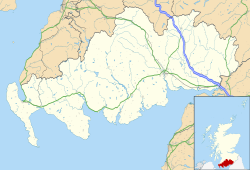Port Logan
| |
|---|---|
Location within Dumfries and Galloway | |
| OS grid reference | NX097405 |
| • Edinburgh | 110 mi (177 km) |
| • London | 299 mi (481 km) |
| Council area | |
| Lieutenancy area | |
| Country | Scotland |
| Sovereign state | United Kingdom |
| Post town | Stranraer |
| Postcode district | DG9 |
| Police | Scotland |
| Fire | Scottish |
| Ambulance | Scottish |
| UK Parliament | |
| Scottish Parliament | |

Port Logan, formerly Port Nessock, is a small village in the parish of Kirkmaiden in the Rhins of Galloway in Wigtownshire. The Gaelic name is Port Neasaig.
Contents
Port Nessock Bay is now all that remains of the western end of a strait that in post-glacial times separated the main part of what is now the Rinns of Galloway from three smaller islands to its south. [1] There was a ruined pier in the bay in 1790, at which time kelp and samphire were gathered on the coast to the south. [2]
The village was planned; it was created by Colonel Andrew MacDowall (Douall), the laird of Logan, in 1818. MacDowall erected a quay and bell tower designed by Thomas Telford, and a causewayed road leading to them. This causeway blocked the view to seaward of the existing houses on the Lower Road (Laigh Row), whose inhabitants MacDowall expected to move to a new Upper Road; in the event, they welcomed the shelter it provided from the brisk onshore winds, and preferred to stay put, though subsequently most of them added a second storey so recovering some of the sea view.[ citation needed ]
